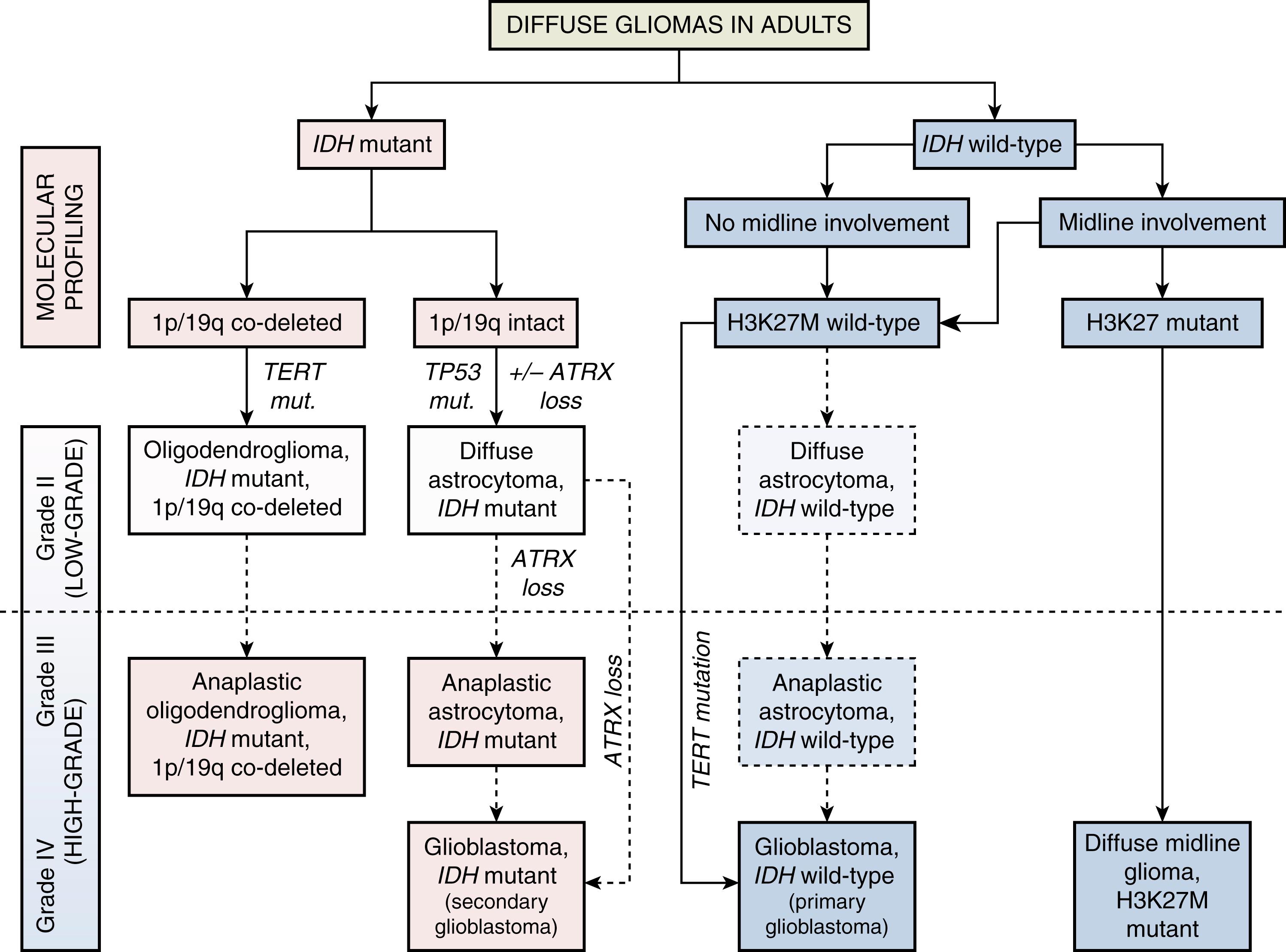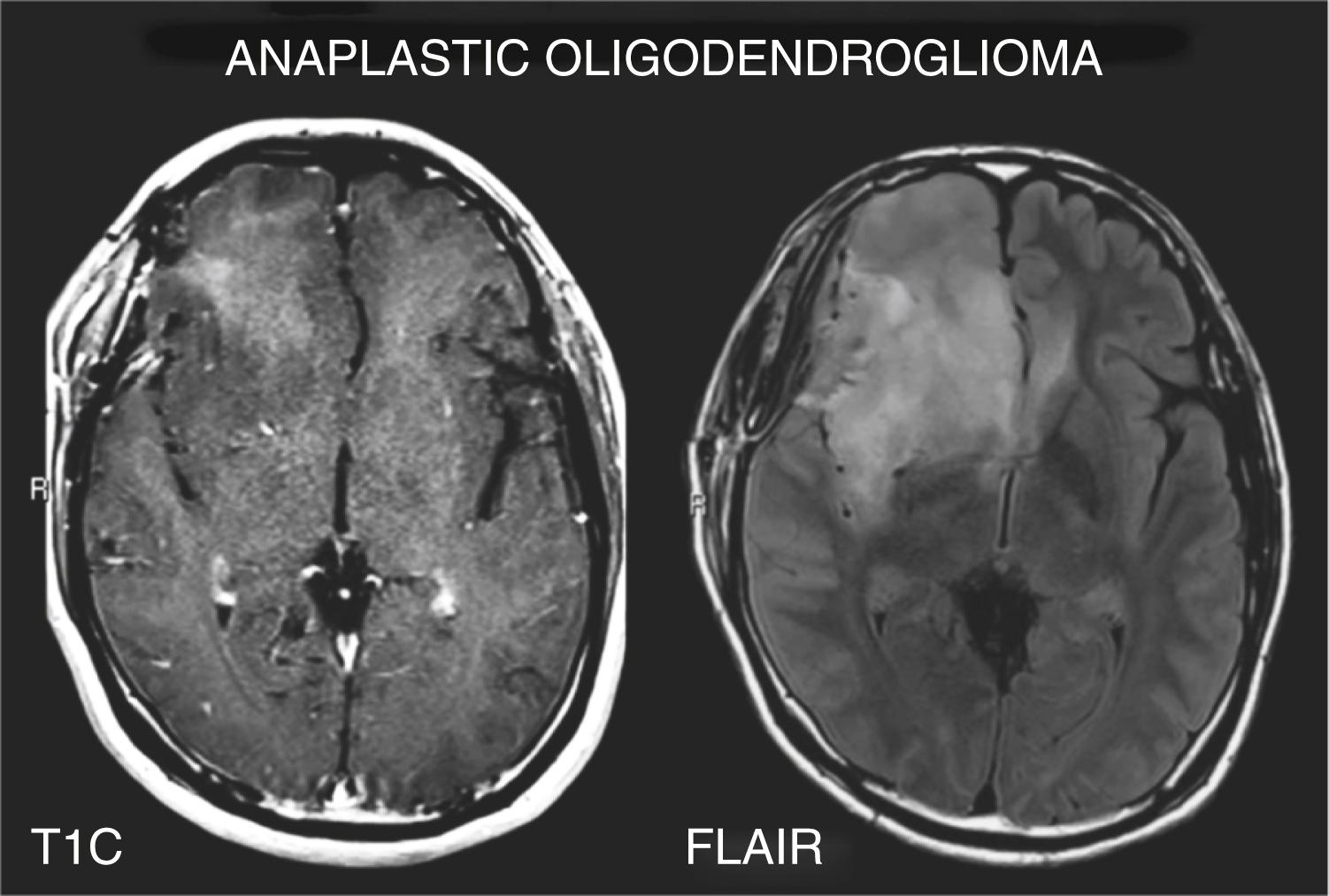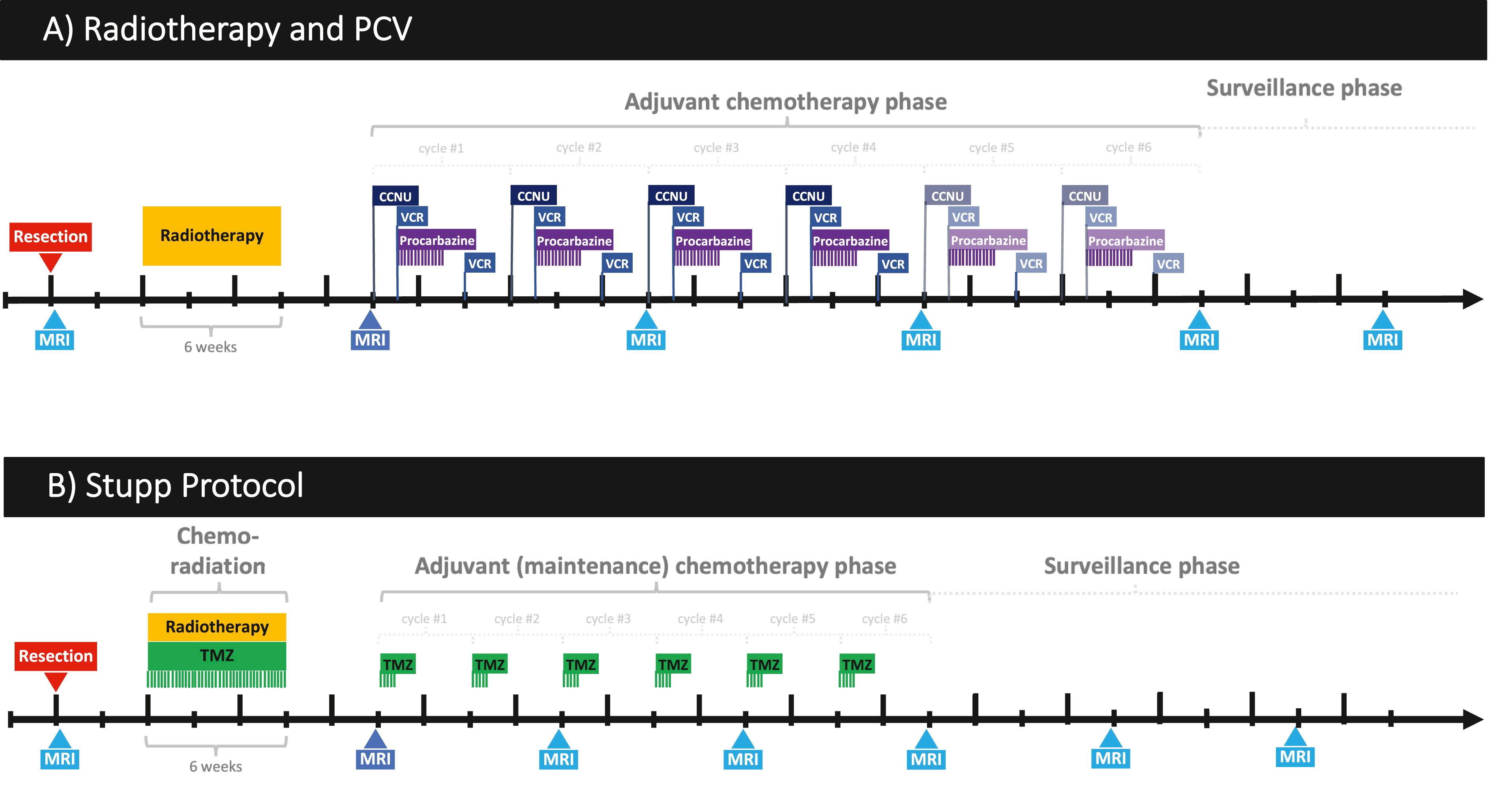Physical Address
304 North Cardinal St.
Dorchester Center, MA 02124
The broad definition of high-grade glioma encompasses all central nervous system neoplasms that are derived from glial components of the brain and show anaplasia (i.e., poor cellular differentiation, atypia, pleomorphism, and loss of normal cellular organization). This chapter focuses on the high-grade diffuse gliomas including anaplastic oligodendrogliomas and astrocytomas, glioblastomas, and the recently added histone-3 K27M mutated diffuse midline gliomas. These tumors were classically labeled WHO grade III or IV based on histopathologic features suggestive of malignant behavior and are considered malignant gliomas. Since 2016, the WHO classification also considers molecular markers. Many of these markers are powerful predictors of survival and, in certain cases, override the histopathologic findings. Beyond the microscopic level, the prognosis is influenced by a myriad of anatomical, clinical, and socioeconomic factors. Consequently, there is a wide range of survival, from months in an untreated elderly person with glioblastoma to decades in a young patient with anaplastic oligodendroglioma. Regardless of which end of the survival spectrum patients are situated, the common denominator is the lack of curative treatment to date. High-grade gliomas almost inevitably recur causing the demise of those affected.
This chapter provides a case-based approach to the management of high-grade gliomas. Case 12.1 presents a patient with anaplastic oligodendroglioma and provides a summary of the clinical presentation and management considerations for these patients. Case 12.2 presents a patient with anaplastic astrocytoma. Case 12.3 provides a multi-step review of the care for patients with glioblastoma including: (1) the initial presentation, (2) management of neurological complications, (3) recognition and treatment of non-neurological complications, and (4) surveillance recommendations and treatment options at recurrence. The chapter ends with a brief summary of H3K27M-mutated diffuse midline gliomas, which is discussed in greater detail in Chapter 7 (Case 7.3).
The field of neuro-oncology is undergoing a major transformation where pathologists and clinicians struggle to incorporate novel molecular data into day-to-day practice. Although there have been a number of incremental updates since its inception, this chapter relies on the 2016 WHO classification ( Chapter 1 ). , According to these criteria, the determination of the type of malignant glioma is first established under the microscope based on the presence of astrocytic or oligodendroglial morphologic features. High-grade is primarily determined by the presence of malignant characteristics. Grade III tumors have anaplastic features, such as nuclear atypia with diffuse or regionally increased cellularity and mitotic activity (Ki-67 proliferative index 5–10%). Grade IV glioblastomas are characterized by microvascular proliferation and/or necrosis and brisk proliferation (Ki-67 >10%) though these may also be seen in anaplastic oligodendrogliomas in the appropriate molecular context.
Following histologic assessment, molecular confirmation is now part of routine diagnostics ( Fig. 12.1 ). Isocitrate dehydrogenase (IDH) gene mutational status separates two major pathways of glioma genesis. Mutant IDH leads to the production of the oncometabolite 2-hydroxyglutarate (2HG). 2HG instigates a series of genetic and epigenetic alterations that result in slowly growing, lower-grade gliomas that eventually progress into high-grade tumors. IDH mutant gliomas have better prognosis and respond favorably to treatment. IDH mutant gliomas are further divided into oligodendrogliomas and astrocytomas, which are mutually exclusive based on the status of chromosomal arms 1p and 19q ( Table 12.1 ). Oligodendrogliomas are defined by loss or co-deletion of chromosomes 1p/19q, which is also predictive of treatment response. They are virtually always IDH mutated, and typically have concurrent TERT promoter alterations. Conversely, IDH mutant astrocytomas (and “secondary glioblastomas”) have intact 1p/19q and are characterized by TP53 and ATRX gene mutations.

| IDH Mutant High-Grade Gliomas | IDH Wild-type High-Grade Gliomas | |||
|---|---|---|---|---|
| Anaplastic Oligodendroglioma | Anaplastic Astrocytoma and Glioblastoma | Anaplastic Astrocytoma and Glioblastoma | Diffuse Midline Glioma, H3K27M mutant | Other Anaplastic Glial Neoplasms |
| 0.1 in 100K/year | 0.4 in 100K/year (AA) 0.3 in 100K/year (GB) |
∼0.15 in 100K/year (AA) 3–4 in 100K/year (GB) |
<0.1 in 100K/year | <0.3 in 100K/year |
|
Rare:
|
Rare or absent:
|
Rare or absent:
|
Anaplastic pleomorphic xanthoastrocytoma:
Anaplastic ganglioglioma:
Anaplastic ependymoma:
|
IDH wild-type astrocytomas are best represented by glioblastomas, which are responsible for 90–95% of this group. These are also referred to as “primary glioblastomas,” as they typically present de novo without a preceding low-grade glioma that gave rise to malignant degeneration. IDH wild-type gliomas have a distinct molecular profile often characterized by TERT promoter mutation. Also common are CDKN2A/B and/or EGFR alterations, whereas TP53 mutations are rare ( Table 12.1 ). A small fraction of IDH wild-type astrocytomas are diagnosed as grade II and III. These are thought to represent an early transient phase of the same disease spectrum. Their clinical course therefore closely resembles primary glioblastoma and differs substantially from IDH mutant astrocytomas of the same grade. A unique subgroup of IDH wild-type astrocytomas harbor a mutation at locus K27 in the histone 3 (H3) gene. Based on their predilection to the thalamus, pons, and spinal cord, these tumors are referred to as diffuse midline gliomas. Given their aggressive behavior noted in the pediatric population, these tumors are automatically classified grade IV even though ∼15% of them lack necrosis or neovascularization.
Methylation of the O6‐methylguanine‐DNA methyltransferase gene promoter (MGMT p ) is the most important predictor of response to alkylating chemotherapy in IDH wild-type astrocytomas, whereas it is much less significant in the presence of an IDH mutation. Additional mutations that exhibited survival benefit when targeted with second-line therapies include BRAF -V600E and NTRK1 gene fusion, yet these are seen in ∼1% of adult gliomas. ,
Case. A 54-year-old female has a history of right frontal grade II oligodendroglioma, IDH1-mutated, 1p19q co-deleted that was treated 11 years ago with radiation with procarbazine, CCNU (lomustine), and vincristine (PCV) chemotherapy. After a long history of well-controlled seizures, she presented with refractory breakthrough focal seizures despite escalating levetiracetam to 2000 mg twice daily and lacosamide to 300 mg twice daily. A contrast-enhanced brain MRI revealed an enlarging T2/fluid attenuated inversion recovery (FLAIR) hyperintense in the right frontal lobe with a new faint region of gadolinium enhancement in the lateral right frontal lobe that had not previously been visible and was concerning for progression to higher grade. The patient was taken to the operating room where maximal safe subtotal resection was performed. Pathology revealed an infiltrative glial neoplasm with round nuclei, perinuclear halos, rare microcalcifications, and an elevated Ki-67 labeling index up to 10%. A final diagnosis of anaplastic oligodendroglioma (WHO grade III) was made. The patient was treated with repeat radiation with concurrent and adjuvant temozolomide chemotherapy with clinical response to treatment and was able to taper antiepileptic regimen to levetiracetam monotherapy at 1500 mg twice daily.
Teaching Points: Approach to Anaplastic Oligodendrogliomas. Anaplastic oligodendrogliomas (AOs) are rare high-grade diffuse gliomas. They are responsible for less than 1% of all primary intracranial neoplasms. Although the annual incidence of AO is 1–2 in a million, they are not uncommon in neuro-oncology subspecialty clinics due to their 10-fold longer survival than those with glioblastoma. Patients’ median age of 50 years at diagnosis places AOs on the older end of the spectrum of IDH mutant tumors. However, they are much younger than those with glioblastomas. AOs are thought to be tumors that develop slowly, and are usually diagnosed de novo . They less commonly progress from a grade II oligodendroglioma after an approximate 6–7-year lead time. ,
Pathology. Anaplastic oligodendrogliomas are characterized by infiltrative cells with round nuclei and perinuclear halo producing a “fried egg” appearance. They have delicate networks of branching capillaries resembling “chicken wire” and variable amounts of microcalcification ( Fig. 12.2 ). Unlike the three-tiered grading system of astrocytomas, oligodendrogliomas are either classified as WHO grade II or III, where the presence of brisk mitotic activity, microvascular proliferation, and necrosis denote the anaplastic (grade III) group. Molecularly, AOs are IDH mutant and 1p/19q co-deleted similarly to their low-grade counterparts; polyploidy is a feature that is more commonly seen in high-grade oligodendrogliomas.

Location and presentation. AOs are almost exclusively supratentorial with a strong predilection to the frontal lobe. They seldom affect infratentorial structures or the spine through leptomeningeal spread. There are a few case reports describing spread beyond the confines of the central nervous system (CNS); however, this is exceedingly rare. As expected, the presenting symptoms depend on the location of the tumor. Partial seizures with or without secondary generalization are by far the most common presenting symptoms of AOs. Seizures affect about 60% AOs, which is only slightly less common than in their low-grade counterparts. The high seizure frequency in these tumors may be explained by the combination of frequent cortical infiltration and 2HG production (see Management of tumor-induced seizures , below). Only 20% of patients present with focal neurologic deficits, which are typically less pronounced than one would expect based on the tumor’s localization and extent. This is most likely due to the slow growth allowing concurrent functional brain reorganization and thus compensation for potential neurologic deficits.
Imaging. AOs present with heterogeneous signal intensity on T2/FLAIR. They often infiltrate the cerebral cortex with variable amount of mass effect on adjacent brain parenchyma ( Fig. 12.2 ). Their margins are relatively indistinct, although they tend to be better demarcated on MRI than glioblastomas. More than 70% of AOs enhance gadolinium-contrast with a typically diffuse and often dotty configuration. This is thought to be the radiographic manifestation of the histologic “chicken wire” vascular pattern and is shared with many grade II oligodendrogliomas. Consequently, contrast-enhanced MRI has a very limited ability to distinguish high- and low-grade oligodendrogliomas. Intratumoral microhemorrhages are common in AOs and can often present with T1-hyperintensities. Oligodendrogliomas in general are the most commonly calcified brain tumors. However, calcification can be observed with other neoplasms such as in pilocytic astrocytomas, ependymal, and glioneuronal tumors and is therefore not pathognomonic.
MR spectroscopy can detect a signal derived from 2HG in vivo . This method may be used to identify and monitor the IDH mutant tumor volume. However, these images are technically difficult to acquire and therefore have not yet made into day-to-day clinical practice. , AOs seem to have the highest apparent diffusion coefficients (ADCs) among high-grade gliomas. Interestingly, oligodendrogliomas generally have elevated relative cerebral blood volume (rCBV) regardless of grade and prognosis. This is again thought to be a correlate of the underlying tortuous microvascular system. Consequently, perfusion-weighted imaging has limited role in the diagnosis or surveillance of these tumors. , A similar phenomenon had been described with PET using amino acid tracers, where both low- and high-grade oligodendrogliomas exhibit high uptake compared with astrocytomas. ,
Surgical approach. The diagnosis of high-grade glioma requires histopathologic confirmation unless such cannot be achieved without significant morbidity. Even with a prior history of histologically proven low-grade oligodendroglioma, surgical confirmation of grade may be helpful, as these tumors often exhibit contrast enhancement without underlying malignant transformation. Furthermore, adequate surgical samples are essential as genetic profiling may have immediate clinical implications. Although resection in anaplastic oligodendroglial tumors has been consistently associated with favorable outcomes, data is lacking from a purely 1p/19q co-deleted AO population. , Hence, the current recommendation of maximal safe resection of the T2/FLAIR hyperintense and/or contrast enhancing volume is extrapolated from low-grade oligodendroglial and mixed high-grade glioma cohorts. Of note, reorganization of functional brain networks is often observed in slower growing tumors, such as AOs progressing from a low-grade intermediary. Consequently, extensive resections are often achievable in tumors situated in conventionally “eloquent” regions. Surgical removal of epileptogenic foci may also improve seizure control in AOs. Nonetheless, surgery is virtually never curative in AOs, and additional treatment covering the infiltrative part of the tumor is fundamental for prolonging survival. Radiation and chemotherapy. Anaplastic oligodendrogliomas are relatively radiosensitive. Monotherapy via standard fractionated external beam radiation has been associated with a median overall survival of approximately 8 years ( Table 12.2 ). Addition of a chemotherapy regimen combining procarbazine, CCNU (lomustine), and vincristine (PCV) administered in 6-week cycles has nearly doubled survival in these patients, as evidenced by two independent randomized controlled phase III trials. , One of these studies reported an almost 15-year overall survival with this regimen. Thus, radiotherapy preceded or followed by PCV has become the standard approach for anaplastic oligodendrogliomas ( Fig. 12.3A ). Although PCV was proven effective, it was also proven relatively toxic, as only half of the patients tolerated four or more cycles. Dose reductions and treatment delays were frequent. Grade III hematologic toxicities were noted in more than 50% of patients enrolled in these trials with neutropenia and thrombocytopenia being the most common. , Myelosuppression is mainly attributed to CCNU and procarbazine, and typically occurs 2–8 weeks after the start of treatment, with a recovery taking 4–6 weeks or longer. CCNU is often associated with a cumulative and even more prolonged cytopenias that may persist years after completion of the treatment. Nausea and emesis affect up to 90% of patients taking this regimen and can be controlled with antiemetics in most cases. Procarbazine also has a weak monoamine oxidase inhibitor effect and thus interacts with enzyme-inducing antiepileptic drugs (AEDs) and selective serotonin reuptake inhibitors and necessitates a low-tyramine diet. Additionally, vincristine’s penetration into brain tumors has been called into question, yet it is a common culprit of peripheral neurotoxicity. This typically manifests as a dose-dependent distal symmetrical sensorimotor axonal neuropathy first presenting with loss of the ankle jerk reflex, followed by often painful paresthesia, and loss of distal vibratory sensation. Vincristine may also contribute to significant constipation due to autonomic neuropathy.
| Diagnosis | WHO Grade |
Prognosis (overall survival, unless indicated) |
|---|---|---|
| Glioblastoma, IDH wild-type, NOS |
IV | Resection only: 4 mo. XRT only: 12.1 mo. XRT/TMZ + adjuvant TMZ: 14.6 mo. XRT/TMZ + adjuvant TMZ/TTF: 20.9 mo. |
| Glioblastoma, IDH wild-type, MGMT p methylated |
IV | XRT only: 15.3 mo. XRT/TMZ + adjuvant TMZ: 23.4 mo. |
| Glioblastoma, IDH wild-type MGMT p unmethylated |
IV | XRT only: 11.8 mo. XRT/TMZ + adjuvant TMZ: 12.6 mo. |
| Diffuse midline glioma, H3K27M mutant | IV | Median OS: 17–31 mo (may be better than in children) |
| Glioblastoma, IDH mutant |
IV | Surgery + XRT: 24 mo. Surgery, XRT/TMZ + adjuvant TMZ: 31 mo. (similar to IDH wild-type AA) |
| Anaplastic Astrocytoma, IDH wild-type |
III | Median OS: 19.2 months |
| Anaplastic Astrocytoma, IDH mutant |
III | Median OS: 9.8 years, likely benefit from combined XRT/TMZ + adjuvant TMZ |
| Anaplastic Oligodendroglioma, IDH mutant, 1p/19q co-deleted | III | XRT only: 7.3–9.3 years XRT and PCV: 14.7 years |
| Anaplastic pleomorphic xanthoastrocytoma | III | 5-year OS: 76% |
| Anaplastic ganglioglioma | III | Median OS: 24.7 mo. |
| Anaplastic ependymoma | III | Progression-free survival: 27.6 months |

Considering all the above, a practical approach to this regimen is to first administer radiotherapy, which is generally well tolerated and “secures” the tumor, then proceed with PCV about 4 weeks after completion of radiation. Although the goal is to administer up to six cycles of PCV, dose reductions are almost always necessary, and maintaining CCNU dosing should be prioritized over procarbazine, whereas discontinuation of vincristine should be considered if any sign of neuropathy emerges ( Fig. 12.3A ).
There is a great desire to adopt a less toxic regimen than PCV, yet it is the regimen with the most evidence of long-term efficacy at the present time. In a trial of anaplastic gliomas comparing monotherapy of radiation, or chemotherapy with either temozolomide or PCV, neither treatment modalities provided superior overall survival to one another. In a retrospective analysis of 1p/19q co-deleted AOs, PCV monotherapy was associated with longer progression-free survival compared with temozolomide alone; those who received radiotherapy combined with either chemotherapy regimen did better than those receiving monotherapy. The results suggest that radiotherapy with concurrent temozolomide, followed by adjuvant temozolomide (i.e., Stupp protocol, Fig. 12.3B ), could serve as an alternative to PCV. This question is currently assessed in the phase III CODEL trial (NCT00887146) comparing the two regimens. Using temozolomide as initial treatment of AOs outside the above trial is generally discouraged unless there are well-justified concerns about PCV not being tolerated or inaccessible.
Become a Clinical Tree membership for Full access and enjoy Unlimited articles
If you are a member. Log in here